|
|
 |
|
Calanoida ( Order ) |
|
|
|
Clausocalanoidea ( Superfamily ) |
|
|
|
Clausocalanidae ( Family ) |
|
|
|
Clausocalanus ( Genus ) |
|
|
| |
Clausocalanus laticeps Farran, 1929 (F,M) | |
| | | | | | | Syn.: | Non Clausocalanus laticeps : Tanaka, 1960 (p.32, figs.F,M) | | | | Ref.: | | | Farran, 1929 (p.208, 224, Descr.F, figs.F); Vervoort, 1951 (p.59, Rem.); 1957 (p.38, Rem.); ? Tanaka, 1964 (p.7); Frost & Fleminger, 1968 (p.42, figs.F,M, Rem.); Ramirez, 1969 (p.53, figs.F, Rem.); Heron & Bowman, 1971 (p.141, figs.F,M, juv.); Séret, 1979 (p.53, figs.F); Björnberg & al., 1981 (p.628, figs.F,M); Razouls, 1994 (p.46, figs.F,M); Bradford-Grieve, 1994 (p.116, figs.F,M, fig.101); Mazzocchi & al., 1995 (p.157, figs.F, Rem.); Bradford-Grieve & al., 1999 (p.878, 916, figs.F,M); Bucklin & al., 2003 (p.335, tab.2, fig.1, Biomol) ; Park & Ferrari, 2009 (p.143, Table 2, biogeography from Southern Ocean); Cheng F. & al., 2013 (p.119, molecular biology, GenBank) |  issued from : B. Frost & A. Fleminger in Bull. Scripps Inst. Oceanogr. Univ. California, San Diego, 1968, 12. [Pl.24, p.148-149: Pl.25, p.150-151; Pl.26, p.152-153]. Female: 1 a, habitus (right lateral view); 1 b, idem (dorsal view); 1 a,b taken from different specimens; 2 a, Th.4-5 (posterior part) and urosome with spermatophore attached (right lateral ); 2 b, B2 of P2; 2 c-e, B2 of P3; 2 f, P5; 2 a-f taken from different specimens; 3 a-b, frontal region (right lateral); 3 c-f, rostrum (right lateral); 3 g, Th.4-5 (posteriro part) and genital segment (right lateral); 3 h, genital segment (ventral view); 3 a taken from one specimen; 3 b,g from another; 3 c,h from a third; 3 d-f from different specimens. Nota: The vaulted forehead is usually a distinctive character of C. laticeps females. Distance L between basipodal spiniform processes 2 and 3 of P3 equal to or more than 2.0 times the proximal width D of process 3 (see figure in C. lividus Pl.1, c). Caudal ramus less than1.65 times as long as wide.
|
 issued from :B. Frost & A. Fleminger in Bull. Scripps Inst. Oceanogr. Univ. California, San Diego, 1968, 12. [Pl.27, p.154-155; Pl.28, p.156-157]. Male: 1 a, habitus (right lateral view); 1 b, idem (dorsal view); 1 c, urosome (armature of caudal rami incomplete) (dorsal view); 1 a-b taken from same specimen; 1 c from another; 2 a, frontal region (right lateral); 2 b, urosome4 (posterior part), urosome5 and caudal rami (armature of caudal rami incomplete) (dorsal view); 2 c-d, B2 of P2 (right and left legs of same specimen); 2 e-f, B2 of P3 (right and left legs of same specimen); 2 g, P5 (right lateral); 2 a,b taken from same specimen; 2 c-g from another. Nota: Basipodal segment 2 spiniform processes 1-3 of P3 slender and tapered uniformly from base (see figure in Clausocalanus lividus Pl.1, c). Caudal ramus more than 1.6 times as long as wide.
|
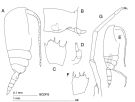 issued from : J.M. Bradford-Grieve in The Marine Fauna of New Zealand: Pelagic Calanoid Copepoda. National Institute of Water and Atmospheric Research (NIWA). New Zealand Oceanographic Institute Memoir, 102, 1994. [p.117, Fig.66]. Female: A, habitus (lateral right side); B, genital somite ( lateral right side); C, basipod 2 of P3; D, P5. Male: E, habitus (lateral right side); F, basipod 2 of P3; G, P5.
|
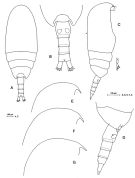 Issued from: M.G. Mazzocchi, G. Zagami, A. Ianora, L. Guglielmo & J. Hure in Atlas of Marine Zooplankton Straits of Magellan. Copepods. L. Guglielmo & A. Ianora (Eds.), 1995. [p.158, Fig.3.27.1]. Female (Central part of Straits of Magellan: off Cape Froward): A, habitus (dorsal); B, urosome (dorsal); C, habitus (lateral right side); D, urosome showing characteristic shape of spermatheque (lateral right side); E-G, differences in the curvature of the rostrum (lateral view). Nota: Proportional lengths of urosomites and furca 34:19:16:15:16 = 100. Points of distal segment of P5 smooth and lacking spinules.
|
 Issued from: M.G. Mazzocchi, G. Zagami, A. Ianora, L. Guglielmo & J. Hure in Atlas of Marine Zooplankton Straits of Magellan. Copepods. L. Guglielmo & A. Ianora (Eds.), 1995. [p.159, Fig.3.27.2]. Female (SEM preparation): A, habitus (dorsal); B, idem (lateral right side); C, forehead with rostral filaments; D, P5: E, detail of bifid terminal points of P5 distal segment. bars: A, B 0.100 mm; C 0.010 mm; D 0.050 mm; D 0.005 mm.
|
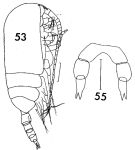 issued from : F.C. Ramirez in Contr. Inst. Biol. mar., Buenos Aires, 1969, 98. [p.50, Lam. VIII, figs.53, 55]. Female (from off Mar del Plata): 53, habitus (lateral right side); 55, P5. Scale bars in mm: 0.1 (53); 0.2 (55).
|
 issued from : B. Frost & A. Fleminger in Bull. Scripps Inst. Oceanogr. Univ. California, 1968, 12. [p.30, Table 2a]. Clausocalanus laticeps Females: Measurements and ratios *.
|
 issued from : B. Frost & A. Fleminger in Bull. Scripps Inst. Oceanogr. Univ. California, 1968, 12. [p.31, Table 2b]. Clausocalanus laticeps males: Measurements and ratios *. r = sample range; m = sample mean; n = number of specimens measured; s = sample standard deviation.
|
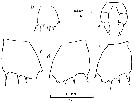 issued from : B. Frost & A. Fleminger in Bull. Scripps Inst. Oceanogr. Univ. California, 1968, 12. [p.153, Pl.26, b, c-e, f]. Female: b, basipodite 2 of P2; c-e, basipodite 2 of P3 (from different specimens); f, P5.
|
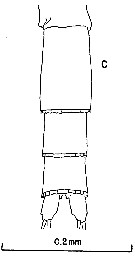 issued from : B. Frost & A. Fleminger in Bull. Scripps Inst. Oceanogr. Univ. California, 1968, 12. [p.155, Pl.27, c]. Male: c, urosome (dorsal).
|
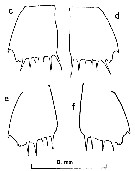 issued from : B. Frost & A. Fleminger in Bull. Scripps Inst. Oceanogr. Univ. California, 1968, 12. [p.157, Pl.28, c-d, e-f]. Male : c-d, basipodite 2 of P2; e-f, basipodite 2 of P3.
|
 issued from : B. Frost & A. Fleminger in Bull. Scripps Inst. Oceanogr. Univ. California, 1968, 12. [p.157, Pl.28, g]. Male: g, P5 (right lateral).
|
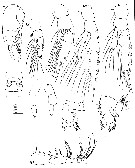 issue from : Heron G.A. & Bowman T.E. in Biology of the Antarctic Seas IV. Antarct. Res. Ser. Washington, 1971, 17. [p.158, Figs.100-109]. Female (from Antractic area): 100, habitus (lateral; scale bar: A); 101, genital field (scale bar: D); 102, right Md (scale bar: C); 103, left Mx1 (scale bar: D); 104, right Mxp (scale bar: C); 105-108, P1 to P4 (scale bar: C); 109, P5 (scale bar: B). All scales in mm.
|
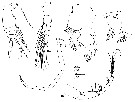 issue from : Heron G.A. & Bowman T.E. in Biology of the Antarctic Seas IV. Antarct. Res. Ser. Washington, 1971, 17. [p.158, Figs.110-115]. Male: 110, habitus (lateral; scale bar: A); 111, right Md (scale bar: C); 112, right Mx1 (scale bar: B); 113, left Mxp (scale bar: left Mxp (scale bar: C); 114, P1 (scale bar: C); 115, P5 (scale bar: C).
|
 Issued from : C. Séret in Thesis UPMC, Paris 6. 1979 [Pl. VII]. Female (from off N Kerguelen Is.): 31, Habitus (dorsal); 32, last thoracic segment and urosome (dorsal); 33, Basipod of P2; 34, basipod of P3; basipod of P2 (another individual); 36, basipod of P3 (other individual); 37, P5; 38, habitus (lateral (third individual); 39, prosome (dorsal view); 40, urosome (lateral) showing digestive tract and genital aerea. Nota: Cephalosome 1.6 times the total body length. Length of abdominal segments and caudal rami 39 : 18 : 13 : 13 : 17 = 100. Caudal rami about 2 times longer than wide. A1 shorter than the cephalosome length.
|
 Issued from : C. Séret in Thesis UPMC, Paris 6. 1979 [Pl. VIII, figs.41-43]. Female (from 50°S--56°S, 75°E-65°E): 41, basipod of P2; 42, basipod of P3: 43, P5.
|
 Issued from : C. Séret in Thesis UPMC, Paris 6. 1979 [p.54]. Female (from off N Kerguelen Is.): Relative lengths (%) of abdominal segments and furca (= caudal rami).
|
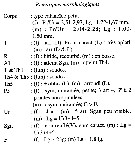 Issued from : C. Razouls in Ann. Inst. océanogr., Paris, 1994, 70 (1). [p.46]. Caractéristiqueq morphologiques de Clausocalanus laticeps femelle et mâle adultes. Terminologie et abbréviations: voir à Calanus propinquus. Nota: Le mâle peut être confondu avec Clausocalanus ingens, cette dernière espèce caractérisée par la longueur du corps; Pr/Sgn (6.,2). Les stades copépodites 1 à 5 sont décrits par Heron & Bowman (1971, p.145-156).
| | | | | Compl. Ref.: | | | Hardy & Gunther, 1935 (1936) (p.147, Rem.); Bary, 1959 (p.14, Fig.5, Table 4, correlation T-S): Senô & al., 1963 a (p.4); Björnberg, 1973 (p.311, 385); De Decker, 1984 (p.315, 343: carte); 1984 a (p.155); Zmijewska, 1987 (tab.2a); Ward, 1989 (tab.2); Atkinson & al., 1990 (tab.1); Santos & Ramirez, 1991 (p.79, 80, 82); Shih & Young, 1995 (p.72); Atkinson & al., 1996 (p.1387, diel periodicity, feeding); Ansorge & al., 1999 (p.135, Table 2, abundance v.s. TS diagram); Atkinson & Sinclair, 2000 (p.46, 50, 51, 55, zonal distribution); Razouls & al., 2000 (p.343, tab. 3, 5, Appendix); Pakhomov & al., 2000 (p.1663, Table 2, transect Cape Town-SANAE antarctic base); Chiba & al., 2001 (p.95, tab.4); Hunt & al., 2001 (p.374, tab.1); Ward & al., 2003 (p.121, tab.4: as Eucalanus laticeps: lapsus calami); Hunt, 2004 (p.1, 47, 74, Table 3.2, 4.4, fig.4.7, 4.11, fig.5.10: seasonal abundance); Berasategui & al., 2005 (p.313, fig.2); Berasategui & al., 2005 (p.485, tab.1); Berasategui & al., 2006 (p.485: fig.2); Hunt & Hosie, 2006 (p.1182, seasonal succession, indicator); 2006 a (p.1203, tab.2, fig.8); Dias & Araujo, 2006 (p.41, Rem., chart); Tsujimoto & al., 2006 (p.140, Table1); Ward & al., 2007 (p.1871, Table 2, abundance); Ward & al., 2008 (p.241, Tabls, Appendix II ); Park & Ferrari, 2009 (p.143, Table 4, Appendix 1, biogeography from Southern Ocean)Takahashi & al., 2010 (p.317, Table 3, 4, figs.4, 5, 6, 7, 8); Ward & al., 2012 (p.78, Table B1, abundance); Thompson G.A. & al., 2012 (p.127, Table 2, 3); Sabatini & al., 2012 (p. 33, Table 3, abundance vs stations transect); Ojima & al., 2013 (p.1293, Table 2, 3, abundance); Lee D.B. & al., 2013 (p.1215, Table 1, abundance, composition); Ward & al., 2014 (p.305, Table 4, abundance in the ''Discovery'' Investigations in the 1930s); Kouwenberg & al., 2014 (p.290, biogeography, Map 7); Acha & al., 2020 (p.p.1, Table 3: occurrence % vs ecoregions, Table 5: indicator ecoregions). | | | | NZ: | 6 | | |
|
Distribution map of Clausocalanus laticeps by geographical zones
|
| | | | | | | | |  issued from : W. Vervoort in B.A.N.Z. Antarctic Reseach Expedition, Reports - Ser. B, Vol. III, 1957 [Fig.9]. issued from : W. Vervoort in B.A.N.Z. Antarctic Reseach Expedition, Reports - Ser. B, Vol. III, 1957 [Fig.9].
Chart showing the geographical distribution (white triangle) in the seas surrounding the Antarctic continent.
Nota: In this chart the area frequented by whaling vessels has been hatched. The Antarctic circle (66°.5 S) has been drawn as a broken line. The numbers I to VI refer to the sectors into which the Antarctic seas are divided according to Mackintosh (1942) (after Vervoort, 1951). |
 issued from : B. Frost & A. Fleminger in Bull. Scripps Inst. Oceanogr. Univ. California, San Diego, 1968, 12. [p.44, Chart 4, a]. issued from : B. Frost & A. Fleminger in Bull. Scripps Inst. Oceanogr. Univ. California, San Diego, 1968, 12. [p.44, Chart 4, a].
Occurrence of C. laticeps in samples examined; closed circles represent samples examined; open circles represent samples in which adults were found; bars through open circles represent samples from which specimens were removed for measurements. |
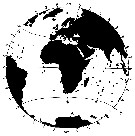 issued from : B. Frost & A. Fleminger in Bull. Scripps Inst. Oceanogr. Univ. California, San Diego, 1968, 12. [p.45, Chart 4, b]. issued from : B. Frost & A. Fleminger in Bull. Scripps Inst. Oceanogr. Univ. California, San Diego, 1968, 12. [p.45, Chart 4, b].
Occurrence of C. laticeps in samples examined; closed circles represent samples examined; open circles represent samples in which adults were found; bars through open circles represent samples from which specimens were removed for measurements. |
 issued from : C. de O. Dias & A.V. Araujo in Atlas Zoopl. reg. central da Zona Econ. exclus. brasileira, S.L. Costa Bonecker (Edit), 2006, Série Livros 21. [p.41]. issued from : C. de O. Dias & A.V. Araujo in Atlas Zoopl. reg. central da Zona Econ. exclus. brasileira, S.L. Costa Bonecker (Edit), 2006, Série Livros 21. [p.41].
Chart of occurrence in Brazilian waters (sampling between 22°-23° S).
Nota: sampling only 2 specimens. |
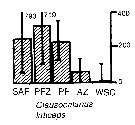 Issued from : A. Atkinson & J.D. Sinclair in Polar Biol., 2000, 23. [p.50, Fig.3] Issued from : A. Atkinson & J.D. Sinclair in Polar Biol., 2000, 23. [p.50, Fig.3]
Clausocalanus laticeps from Scotia Sea.
Median and interquartile ranges of copepods (nos /m2) in the five water zones; from north to south these are SAF Subantractic Front area, PFZ Polar frontal Zone, PF Polar Front area, AZ Antarctic Zone, WSC Weddell-Scotia Confluence area/ East Wind Drift.
Numbers on the plots are upper interquartiles where these could not be scaled. |
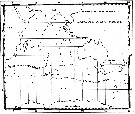 Issued from : C. Séret in Thesis 3ème Cycle, UPMC, Paris 6. 1979, Annexe. [p.26]. Issued from : C. Séret in Thesis 3ème Cycle, UPMC, Paris 6. 1979, Annexe. [p.26].
Geographical occurrences of Clausocalanus laticeps in the Indian Ocean and Antarctic zone. [after publications from: Brady, 1883, 1918; Thompson, 1900; Wolfenden, 1908, 1911; With , 1915; Rosendorn, 1917; Farran, 1929; Sewell, 1929, 1947; Brady & Gunther, 1935; Steuer, 1929, 1392, 1933; Ommaney, 1936; Vervoort, 1957; Tanaka, 1960; Brodsky, 1964; Seno, 1966; Andrews, 1966; Grice & Hulsemann, 1967; Seno, 1966; Frost & Fleminger, 1968; Voronina, 1970; Zverva, 1972].
C. Séret notes the occurrence at stations 56°S, 70°E; 51°,65°E and 50°S, 75°E !where the the number of individuals is very important in the latter station). |
 Issued from : J.H.M. Kouwenberg, C. Razouls & N. Desreumaux in Biogeographic Atlas of the Southern Ocean, Scient. Comm. Antarct. Res., Cambridge, 2014, 6.6. [p.293, Map 8]. Issued from : J.H.M. Kouwenberg, C. Razouls & N. Desreumaux in Biogeographic Atlas of the Southern Ocean, Scient. Comm. Antarct. Res., Cambridge, 2014, 6.6. [p.293, Map 8].
Distribution of Clausocalanus laticeps. |
| | | | Loc: | | | Antarct. (Amundsen Sea, Peninsula, Drake Passage, Scotia Sea, SW Atlant., Indian, Lützow-Holm Bay, SW Pacif.), sub-Antarct. (N South Georgia, SW & SE Atlant., off Prince Edward Is., Indian, SW & SE Pacif.), Magellan Strait, off S South Africa, Indian (subtropical convergence), off S New Zealand, SE North Island, Chile, SW Atlant. (Malvinas current, Patagonia, Mar del Plata), SE Atlant., Brazil (Vitoria-Cabo de Sao Tomé), China Seas (East China Sea, in Shih & Young, 1995, in Zhang & al., 2010) | | | | N: | 64 | | | | Lg.: | | | (25) F: 1,65-1,43; (30) F: 1,67-1,25; M: 1,1-1,01; (31) F: 1,55-1,5; (35) F: 1,65-1,32; (36) F: 1,49-1,27; (246) F: 1,45-1,1; (371) F: 1,55-1,35; M: 1,3-1; {F: 1,10-1,67; M: 1,00-1,30}
The mean female size is 1.445 mm (n = 14; SD = 0.1697), and the mean male size is 1.103 (n = 4; SD = 0.1391). The size ratio (male : female is about 0.76. | | | | Rem.: | Epipelagic. Oceanic.
Sampling depth (Antarctic, sub-Antarctic): 500-700 m.
For Vervoort (1957, p.59) the species is recognized by the curiously shaped cephalon and flattened frontal part of the head. In spite of the abundance of females at 51°11'S, 11°17'E and a prolonged search the author has not found a single adult male.
For Frost & Fleminger (1968, p.43) the possibility of confusing with C. ingens dictates that locality records of laticeps should be treated with reserve.
The presence of this species in the eastern Chinese Sea needs confirmation. | | | Last update : 03/04/2020 | |
|
|
 Any use of this site for a publication will be mentioned with the following reference : Any use of this site for a publication will be mentioned with the following reference :
Razouls C., Desreumaux N., Kouwenberg J. and de Bovée F., 2005-2025. - Biodiversity of Marine Planktonic Copepods (morphology, geographical distribution and biological data). Sorbonne University, CNRS. Available at http://copepodes.obs-banyuls.fr/en [Accessed August 17, 2025] © copyright 2005-2025 Sorbonne University, CNRS
|
|
 |
 |

























